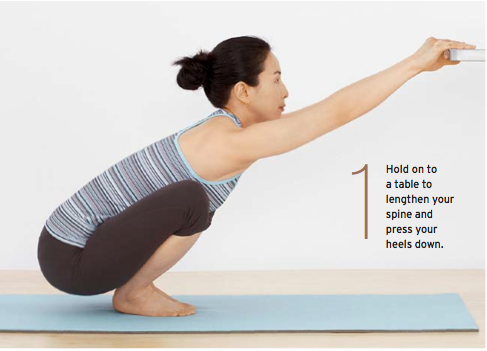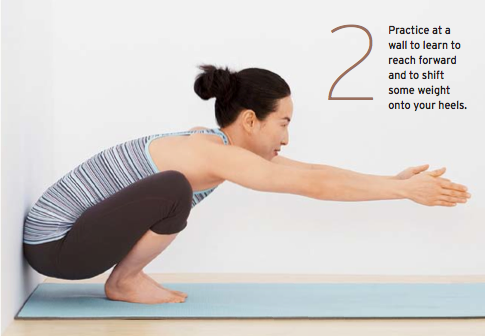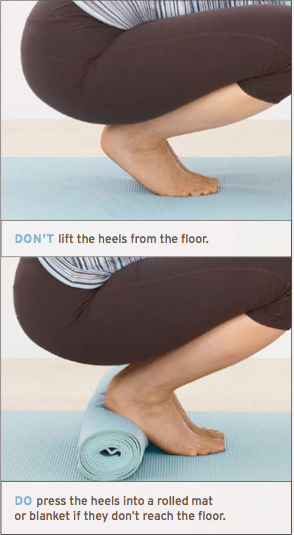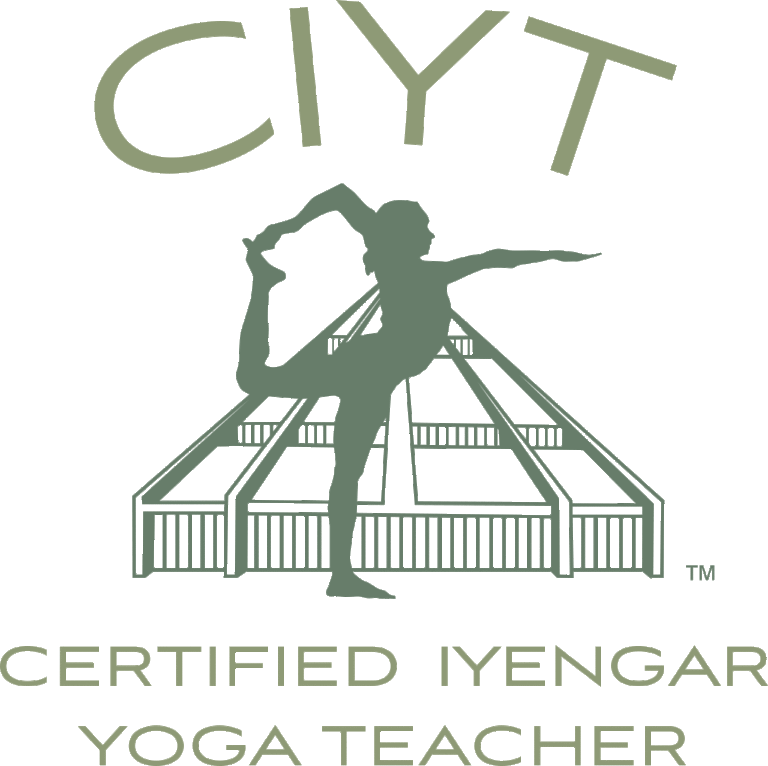Originally published in Yoga Journal (Basics Column)
I am always amazed when I visit India and see people who can work for hours while effortlessly squatting on the ground. Many of us who were raised sitting on chairs rather than on the floor have lost the ability to squat with ease and the benefits that squatting can have on our posture: stretching the back, elasticizing the knees and ankles and regulating the digestive system. In this squatting forward bend, your back is released from head to tail as the ankles, knees, hips, and entire spine are flexed. The back is long, rounded and soft and the arms encircle the body.
When talking about the art of yoga, B.K.S. Iyengar often refers to the rhythm of the asana, the succession of actions that lead to an uninterrupted flow of awareness throughout your entire system. When the actions of each part of your body are coordinated so that none are acting alone and no individual area is overpowering, you can experience this inner rhythm and a sense of wholeness in the pose, as if all parts of yourself are expressing themselves evenly. Those of you who feel that you don’t get far with forward bending because of tight hamstrings can experience the rhythm of forward bends in this compact pose. The spine reaches forward while the heels root the hips backwards. In the process the whole spine is lengthened as on the one end of the pose the sacrum moves down towards the floor and on the other end the head and neck are lengthened away from the lower spine, also going down towards the floor. In addition to strengthening and stretching the feet and ankles and increasing mobility in your hips, you will feel a vertical extension and horizontal broadening of the muscles in your back.
The pressure of the heel on the floor plays a vital role as a counterpoint to the head, keeping you grounded as you extend. If you are tight in your hips, groins, calves and Achilles tendons, your heels may not reach the floor so the first two variations of the pose will help you to loosen those regions and enable the heels to press downward. If you cannot reach your heels to the floor in the final variation, use a rolled blanket or mat under your heels.
If your knee aches in the pose, you can decrease the flexion of the knees by placing a blanket behind them in between the calves and thighs. The thicker the blanket, the more space you will make in the backs of your knees. Use it behind both knees, even if you only feel pressure on one side.
In this variation, you are going to hold onto something firm to help stabilize yourself while you learn the action of the feet and ankles and lengthen the spine. This will help you to stretch your calves and ankles so that you can reach your heels to the floor. The object you hold onto should be fixed and secure. A doorknob is a good height if the door is stable or you can open the door and hold the two doorknobs on either side of the door. You can also hold onto wall ropes, a countertop, a sturdy heavy table, a bed-frame, or a banister – something high enough so that your arms are reaching upwards while squatting.
Stand with your feet touching each other, catch a hold of your fixed object and step back a couple of feet. Exhale and bend your knees and squat so that your knees are in front of your ankles and your heels are under your buttocks. If you are sitting on top of your heels, step your feet a little further back away from the wall or table. Your buttocks should descend but they shouldn’t be resting on the heels. If your heels are lifted up in the air, walk your feet a little closer until you can just barely reach your heels to the floor.
Keep your feet together, press the inner edges (big toe side) of your heels to the floor and extend the calf muscles down towards the heels. Lengthen the toes forward on the floor and pull your heels back as if the bottom of your foot were becoming longer on the floor. Pull on the table, inhale and lift the sides of your ribcage and waist up. As your torso rises, move your hips and buttocks down. To come out of the pose, inhale and pull on the table to stand up and straighten your legs.
Now you are going to do the pose with your buttocks supported to keep your hips and heels grounded while reaching the spine forward.
Stand with your sacrum against a wall and your feet approximately six inches away from the wall. Bend your knees and slide the buttocks down the wall until you are squatting. If your heels don’t reach the floor, step your feet a little further away from the wall. If you find that your buttocks are sinking down to the floor, step back a little closer to the wall. As in the previous variation of the pose, your heels should just barely touch the floor. Keeping the feet together, spread your knees apart, press the heels down and stretch them back towards the wall. The bottom of your sacrum should remain on the wall as you extend your arms, side ribs and waist away from the wall in between your legs.
Reach from the bottom of your waist to your hands and extend your arms and chest parallel to the floor. The more you reach forward with your torso, the more you have to ground the heels back and down. Keep your inner heels down so that the weight doesn’t fall onto the outside edge of your foot. Look down at the floor.
The knees need to separate but don’t spread the legs so wide that they lose contact with the torso. Move your inner thighs back and down towards the hip socket while you bring your outer thighs forward and up towards the knees. Lift the front of your shin while you lengthen the back of your calf down. Find the rhythm in balancing the forward stretch of the torso and rooting of the thighs into the hips sockets as you ground your heels. Similarly, balance the work of the inner and outer thighs, front and back of the lower legs. You will find that you are playing on the edge of sitting and extending.
To come out of the pose, take your hands to the wall, keep your head down as you lift your hips up towards the ceiling and straighten your legs in a forward bend, Uttanasana. Remain in Uttanasana for a few moments to extend the knees.
If your heels don’t reach the floor in this variation, place a rolled blanket under your heels so that they have something to press into. Start in a standing forward bend, Uttanasana with your hands on the floor in front of you and bend your knees into a squat. Keep your feet together, heels down and spread the knees apart reaching forward in between your legs with the arms and chest parallel to the floor. Push your inner heels down, lengthen the sides of your waist away from your hips and the chest forward. Move your inner thigh muscles back from the knees towards the pelvis. The very top inner root of the thigh at the groin should relax to give you the freedom to pull your torso away from your legs. As the hips and inner thighs move back they should feel like a counter balance to your torso.
Exhale and bend your elbows with your arms still in between your legs and place your palms on the floor. Don’t let the sides of your waist shrink or retract as you turn your arms back to reach your hands around the outside edges of the ankles and catch hold of the feet. In this position, your shoulders are underneath your knees and the arms are said to resemble a garland hanging around the neck. Pull on the heels and exhale to take your head towards the floor.
Here you can see whether or not the weight on one foot is tilting to its’ outer edge or if the feet are coming apart from each other. Press both inner heels down evenly and extend the toes forward. In the process of pulling the tops of your thighs and hips back, you may feel the buttocks lift slightly. Take your inner thighs back and buttocks down as you bring your head closer to the floor.
Even though you are drawn into a compact ball in this pose, the waist and ribs should continue to lengthen forward as if getting pulled out of your hips. Take a few smooth breaths to work on the rhythmic balance of rooting and extending, spreading and lengthening. Soften your throat and allow the entire back of your body from the tailbone to the head to release into this full forward bend.
To come out, let go of your ankles, place your hands on the floor in front of your feet, inhale and straighten your legs coming into Uttanasana. Extend the backs of your legs as you release your head and neck down.
Benefits:
Ankles
Hips
Lower back
Strengthens abdomen
Contraindications:
Knee injury
DON’T
Lift the heels from the floor.
DO
Press the heels into a rolled blanket if they don’t reach the floor.





